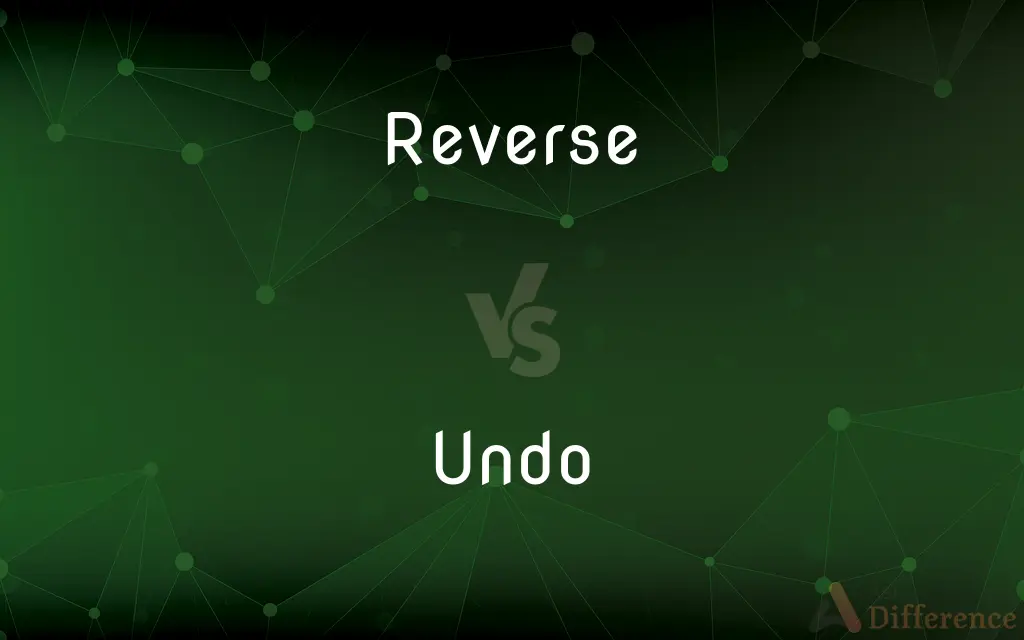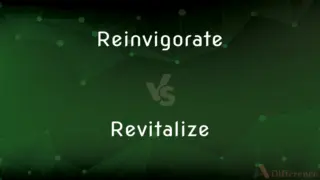Reverse vs. Undo — What's the Difference?
Edited by Tayyaba Rehman — By Urooj Arif — Updated on March 25, 2024
Reverse means to change something to its opposite direction or state, while undo implies canceling or nullifying a previous action or its effects.

Difference Between Reverse and Undo
Table of Contents
ADVERTISEMENT
Key Differences
Reversing something typically involves a change in direction, order, or position, making it the opposite of its current state. This can apply to physical movements, like reversing a car, or conceptual changes, such as reversing a decision. On the other hand, undoing something is more about negating an action or decision, effectively attempting to return to the state before that action was taken, as commonly seen in computer operations where an undo function can remove the last change made to a document.
While reverse can imply a more comprehensive and often physical or tangible change, undo tends to be used in contexts where actions are negated or removed, especially in digital or abstract scenarios. For example, reversing a trend involves significant shifts in direction or behavior, whereas undoing a typo involves simply removing or correcting the last few keystrokes.
In some contexts, reverse can carry the connotation of returning something to a previous state, overlapping somewhat with the concept of undo. However, reverse often entails a more active or deliberate process of change, whereas undo typically focuses on the cancellation or removal of recent actions or their effects.
The usage of reverse can imply a deliberate effort to alter a situation, process, or decision, often requiring significant effort or intervention. Undo, by contrast, is frequently associated with quick fixes or corrections, particularly in software applications where an undo function allows users to easily revert recent changes.
Despite their differences, both reverse and undo are important concepts in various fields, from technology and computing to decision-making and physical processes. Understanding the nuances between them can enhance clarity in communication and decision-making processes.
ADVERTISEMENT
Comparison Chart
Definition
Changing something to its opposite state or direction
Canceling or nullifying a previous action or its effects
Application
Often physical or tangible changes
Typically negating actions, especially in abstract scenarios
Contexts
Physical movements, decisions, trends
Digital operations, minor corrections
Connotation
Comprehensive change, active alteration
Quick fixes, cancellation, correction
Process
Can be complex and deliberate
Often simple, with immediate effect
Example Usage
Reversing a vehicle, reversing a policy
Undoing a typo, undoing a command in software
Compare with Definitions
Reverse
Making something the opposite of what it is or was.
The company decided to reverse its earlier decision to downsize.
Undo
To cancel or nullify the effects of a previous action.
Pressing Ctrl + Z can undo the last change made in a document.
Reverse
Implies a significant change in state or order.
The new manager aimed to reverse the decline in sales.
Undo
Associated with simple, immediate reversals of actions.
Undoing an accidental email deletion restored the message to the inbox.
Reverse
Often requires deliberate action or intervention.
Reversing the effects of pollution requires concerted global efforts.
Undo
Typically involves less significant or complex changes.
The artist decided to undo the last brush stroke to maintain the painting's balance.
Reverse
Applies to various scenarios from physical to conceptual.
Technological advancements have the potential to reverse trends in resource depletion.
Undo
Often involves correcting mistakes or removing recent changes.
The editor used the undo feature to revert the last few edits.
Reverse
Used in contexts involving directional shifts.
Learning to reverse park is essential for new drivers.
Undo
Commonly used in software and abstract scenarios.
The new software update allows users to undo multiple actions at once.
Reverse
Turned backward in position, direction, or order
The reverse side of the poster.
Undo
Undo is an interaction technique which is implemented in many computer programs. It erases the last change done to the document, reverting it to an older state.
Reverse
Moving, acting, or organized in a manner contrary to the usual
In reverse order.
Undo
To reverse or erase; annul
Impossible to undo the suffering caused by the war.
Reverse
Causing backward movement
A reverse gear.
Undo
To untie, disassemble, or loosen
Undo a shoelace.
Reverse
(Printing) Printed in such a way that the normally colored part appears white against a colored or black background.
Undo
To open (a parcel, for example); unwrap.
Reverse
The opposite or contrary
All along we thought Sue was older than Bill, but just the reverse was true.
Undo
To cause the ruin or downfall of; destroy.
Reverse
The back or rear part
The reverse of the flyer.
Undo
To throw into confusion; unsettle.
Reverse
The side of a coin or medal that does not carry the principal design; the verso.
Undo
To come open or unfastened.
Reverse
A change to an opposite position, condition, or direction.
Undo
To reverse the effects of an action.
Fortunately, we can undo most of the damage to the system by the war.
Reverse
A change in fortune from better to worse; a setback
Suffered financial reverses.
Undo
To unfasten.
Could you undo my buckle for me?
Reverse
A mechanism, such as a gear in a motor vehicle, that is used to reverse movement.
Undo
(figuratively) To impoverish or ruin, as in reputation; to cause the downfall of.
Reverse
The position or operating condition of such a mechanism.
Undo
(computing) An operation that reverses a previous action.
How many undos does this program support?
Reverse
Movement in an opposite direction.
Undo
To reverse, as what has been done; to annul; to bring to naught.
What's done can not be undone.
To-morrow, ere the setting sun,She 'd all undo that she had done.
Reverse
(Football) An offensive play in which a ball carrier running in one direction executes a handoff to a player running in the opposite direction.
Undo
To loose; to open; to take to piece; to unfasten; to untie; hence, to unravel; to solve; as, to undo a knot; to undo a puzzling question; to undo a riddle.
Pray you, undo this button.
She took the spindle, and undoing the thread gradually, measured it.
Reverse
To turn around to the opposite direction
The wind reversed the weather vane.
Undo
To bring to poverty; to impoverish; to ruin, as in reputation, morals, hopes, or the like; as, many are undone by unavoidable losses, but more undo themselves by vices and dissipation, or by indolence.
That quaffing and drinking will undo you,
Reverse
To turn inside out or upside down
Reverse a jacket.
Undo
Cancel, annul, or reverse an action or its effect;
I wish I could undo my actions
Reverse
To exchange the positions of; transpose
Reversed the people on stage.
Undo
Deprive of certain characteristics
Reverse
(Law) To change or set aside (a lower court's decision).
Undo
Cause the ruin or downfall of;
A single mistake undid the President and he had to resign
Reverse
To cause to adopt a contrary viewpoint
Reversed himself during the campaign.
Undo
Cause to become loose;
Undo the shoelace
Untie the knot
Loosen the necktie
Reverse
To change to the opposite
Reversed their planned course of action.
Undo
Remove the outer cover or wrapping of;
Let's unwrap the gifts!
Undo the parcel
Reverse
To cause (an engine or mechanism) to function in reverse.
Reverse
To direct that (a charge) apply to the person receiving instead of making a telephone call.
Reverse
To turn or move in the opposite direction.
Reverse
To reverse the action of an engine.
Reverse
Opposite, contrary; going in the opposite direction.
We ate the meal in reverse order, starting with dessert and ending with the starter.
The mirror showed us a reverse view of the scene.
Reverse
Pertaining to engines, vehicle movement etc. moving in a direction opposite to the usual direction.
He selected reverse gear.
Reverse
To be in the non-default position; to be set for the lesser-used route.
Reverse
Turned upside down; greatly disturbed.
Reverse
(botany) Reversed.
A reverse shell
Reverse
(genetics) In which cDNA synthetization is obtained from an RNA template.
Reverse
In a reverse way or direction; in reverse; upside-down.
Reverse
The opposite of something.
We believed the Chinese weren't ready for us. In fact, the reverse was true.
Reverse
The act of going backwards; a reversal.
Reverse
A piece of misfortune; a setback.
Reverse
The tails side of a coin, or the side of a medal or badge that is opposite the obverse.
Reverse
The side of something facing away from a viewer, or from what is considered the front; the other side.
Reverse
The gear setting of an automobile that makes it travel backwards.
Reverse
A thrust in fencing made with a backward turn of the hand; a backhanded stroke.
Reverse
(surgery) A turn or fold made in bandaging, by which the direction of the bandage is changed.
Reverse
(transitive) To turn something around so that it faces the opposite direction or runs in the opposite sequence.
To reverse the order of books on a shelf
To reverse a portion of video footage
Reverse
(transitive) To turn something inside out or upside down.
Reverse
(transitive) To transpose the positions of two things.
Reverse
(transitive) To change totally; to alter to the opposite.
All trends reverse eventually.
Reverse
To return, come back.
Reverse
To turn away; to cause to depart.
Reverse
To cause to return; to recall.
Reverse
(legal) To revoke a law, or to change a decision into its opposite.
To reverse a judgment, sentence, or decree
Reverse
To cause a mechanism to operate or move in the opposite direction to normal; to drive a vehicle in the direction the driver has the back.
Reverse
(chemistry) To change the direction of a reaction such that the products become the reactants and vice-versa.
Reverse
To place (a set of points) in the reverse position.
Reverse
To move from the normal position to the reverse position.
Reverse
To engage reverse thrust on (an engine).
Reverse
To overthrow; to subvert.
Reverse
(computing) reverse-engineer
Reverse
Turned backward; having a contrary or opposite direction; hence; opposite or contrary in kind; as, the reverse order or method.
Reverse
Turned upside down; greatly disturbed.
He found the sea diverseWith many a windy storm reverse.
Reverse
Reversed; as, a reverse shell.
Reverse
That which appears or is presented when anything, as a lance, a line, a course of conduct, etc., is reverted or turned contrary to its natural direction.
He did so with the reverse of the lance.
Reverse
That which is directly opposite or contrary to something else; a contrary; an opposite.
And then mistook reverse of wrong for right.
To make everything the reverse of what they have seen, is quite as easy as to destroy.
Reverse
The act of reversing; complete change; reversal; hence, total change in circumstances or character; especially, a change from better to worse; misfortune; a check or defeat; as, the enemy met with a reverse.
The strange reverse of fate you see;I pitied you, now you may pity me.
By a reverse of fortune, Stephen becomes rich.
Reverse
The back side; as, the reverse of a drum or trench; the reverse of a medal or coin, that is, the side opposite to the obverse. See Obverse.
Reverse
A thrust in fencing made with a backward turn of the hand; a backhanded stroke.
Reverse
A turn or fold made in bandaging, by which the direction of the bandage is changed.
Reverse
To turn back; to cause to face in a contrary direction; to cause to depart.
And that old dame said many an idle verse,Out of her daughter's heart fond fancies to reverse.
Reverse
To cause to return; to recall.
And to his fresh remembrance did reverseThe ugly view of his deformed crimes.
Reverse
To change totally; to alter to the opposite.
Reverse the doom of death.
She reversed the conduct of the celebrated vicar of Bray.
Reverse
To turn upside down; to invert.
A pyramid reversed may stand upon his point if balanced by admirable skill.
Reverse
Hence, to overthrow; to subvert.
These can divide, and these reverse, the state.
Custom . . . reverses even the distinctions of good and evil.
Reverse
To overthrow by a contrary decision; to make void; to under or annual for error; as, to reverse a judgment, sentence, or decree.
Reverse
To return; to revert.
Reverse
To become or be reversed.
Reverse
A relation of direct opposition;
We thought Sue was older than Bill but just the reverse was true
Reverse
The gears by which the motion of a machine can be reversed
Reverse
An unfortunate happening that hinders of impedes; something that is thwarting or frustrating
Reverse
The side of a coin or medal that does not bear the principal design
Reverse
(American football) a running play in which a back running in one direction hands the ball to a back running in the opposite direction
Reverse
Turning in the opposite direction
Reverse
Change to the contrary;
The trend was reversed
The tides turned against him
Public opinion turned when it was revealed that the president had an affair with a White House intern
Reverse
Turn inside out or upside down
Reverse
Rule against;
The Republicans were overruled when the House voted on the bill
Reverse
Annul by recalling or rescinding;
He revoked the ban on smoking
Lift an embargo
Vacate a death sentence
Reverse
Directed or moving toward the rear;
A rearward glance
A rearward movement
Reverse
Reversed (turned backward) in order or nature or effect
Reverse
Of the transmission gear causing backward movement in a motor vehicle;
In reverse gear
Common Curiosities
Is reversing a trend the same as undoing past actions?
Reversing a trend involves broader changes and may not directly negate past actions, whereas undoing typically focuses on canceling specific actions or effects.
Is reversing always possible in physical processes?
Not all physical processes are reversible, especially those that involve significant changes or irreversible actions.
How does the concept of entropy relate to the ability to reverse processes?
In thermodynamics, entropy is a measure of disorder; many processes that increase entropy (like mixing substances) are practically irreversible, highlighting the complexity of reversing certain changes.
How do reverse and undo apply in the context of time?
Neither reverse nor undo can literally alter the passage of time, but they can change the outcomes or states resulting from actions taken over time.
What are the limitations of the undo function in software?
The undo function may have limitations regarding the number of actions it can revert and may not be available for all types of changes.
Can reversing a decision have immediate effects like undoing an action in software?
Reversing a decision can have immediate or long-term effects, but the process and impact tend to be more complex compared to the straightforward undo function in software.
How does the undo function work in digital applications?
The undo function in digital applications typically reverts the most recent changes made by the user, restoring the previous state of the document or file.
Can major decisions be undone in the same way as in digital platforms?
Major decisions often require more than a simple undo action; reversing such decisions might involve complex processes and significant consequences.
Can the terms reverse and undo be used interchangeably?
While they have similar connotations in some contexts, they are not always interchangeable due to their distinct implications regarding the scope and nature of the changes involved.
What ethical considerations might arise when reversing decisions or actions?
Ethical considerations can include the impact on people affected by the original decision or action, the transparency of the reversal process, and the potential for setting precedents.
Share Your Discovery

Previous Comparison
Gumtree vs. Eucalyptus
Next Comparison
Reinvigorate vs. RevitalizeAuthor Spotlight
Written by
Urooj ArifUrooj is a skilled content writer at Ask Difference, known for her exceptional ability to simplify complex topics into engaging and informative content. With a passion for research and a flair for clear, concise writing, she consistently delivers articles that resonate with our diverse audience.
Edited by
Tayyaba RehmanTayyaba Rehman is a distinguished writer, currently serving as a primary contributor to askdifference.com. As a researcher in semantics and etymology, Tayyaba's passion for the complexity of languages and their distinctions has found a perfect home on the platform. Tayyaba delves into the intricacies of language, distinguishing between commonly confused words and phrases, thereby providing clarity for readers worldwide.
















































